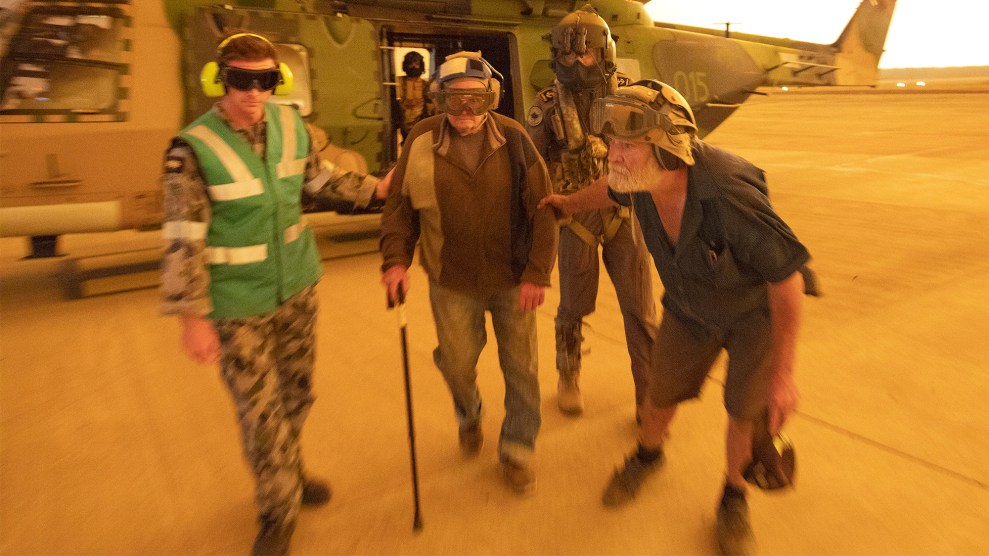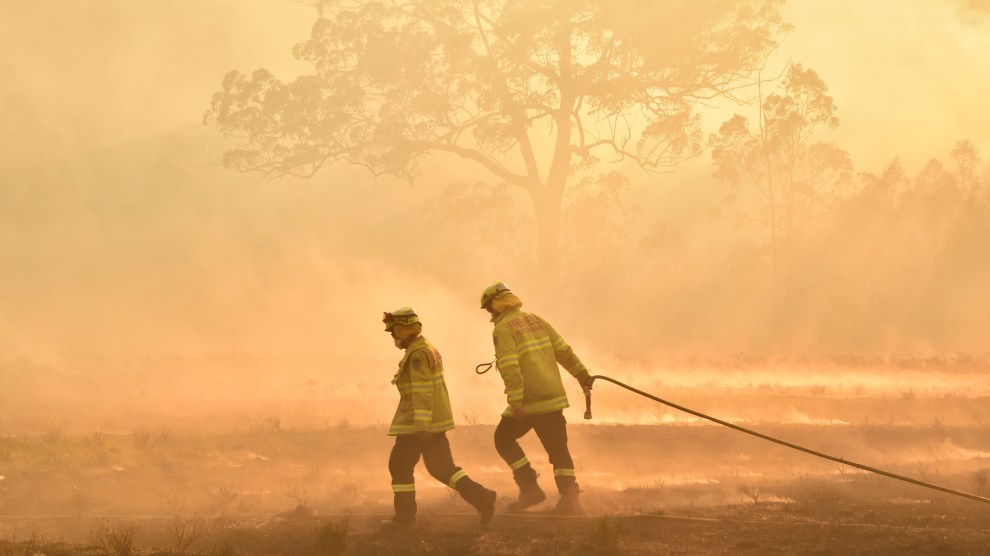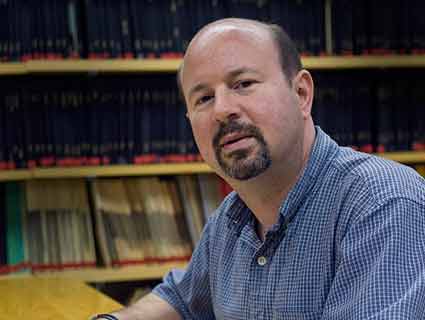
Evacuees flee disastrous wildfires in Australia with the help of a military helicopter.Kelvin Hockey/Royal Australian Navy/Zuma
One of the most prominent scientists studying climate change is Michael Mann, a climatologist and atmospheric science professor at Penn State University who has been a leader in explaining the contribution that human behavior has made in creating and exacerbating the climate crisis. He was one of the scientists who created the hockey stick graph, a popular visualization of mean global temperatures of the past several centuries, showing a sudden jump starting in the 20th century.
During his sabbatical year, Mann decided to visit Australia to study the effects of climate change on the scene of bleaching coral reefs and extreme weather events. He didn’t plan for his visit to coincide with the catastrophic wildfires, but he’s now found himself at what he calls “the front lines.”
“There is no precedent for the scale and speed at which these brushfires are spreading,” Mann tells the Mother Jones Podcast. “It’s almost like we’re being given a vision for our future if we don’t act on climate.”
To better understand the forces behind this season’s fires, Mother Jones’s James West, who happens to be Australian, spoke with Mann for this week’s edition of Mother Jones Podcast:
Since September, the combination of soaring temperatures and a severe drought has triggered wildfires across Australia that have enveloped more than six times the land burned during California’s devastating 2018 wildfire season. The current blazes encompass an area about the size of Scotland and have released an estimated 200 million tons of carbon dioxide—equivalent to about 40 percent of the country’s annual average carbon emissions—into the atmosphere above the state of New South Wales, where the fires have been the most devastating. With more than 100 separate fires still burning, the end isn’t anywhere in sight. Some estimates have wildfires continuing for months into 2020.
The consequences are only starting to be tallied: At least 25 people have been killed, and about 3,000 military personnel have mobilized to assist in the evacuation of about 100,000 residents across NSW and Victoria. The toll on the ecosystem remains less clear, but a widely reported estimate puts the number of wildlife killed at 480 million, not including frogs, bats, or insects.
Meanwhile, the Australian government is led by conservative Prime Minister Scott Morrison, who has deep ties to the coal industry and a history of indifference toward climate change. His government, critics say, belatedly has allocated $1.4 billion to fire recovery efforts, buttressed with a promise that “whatever it costs, we will ensure the resilience and future of this country.” For many Australians, the fire has diminished the value of the prime minister’s word—he’s been criticized for vacationing in Hawaii while the wildfires were in full force in December. During public appearances, hecklers haven’t minced words, calling him “an idiot.” Morrison’s indecisive behavior on the fires flies in the face of the scientific assessment that climate change has been a major contributor to their intensity.
A transcript of the Mother Jones Podcast interview has been edited for clarity and length below:
Michael Mann, thanks for joining the Mother Jones Podcast. Now it just happens that you’re in Australia. Tell us why.
I’m going to be doing research here with some other climate scientists at the University of New South Wales trying to understand the linkages between climate change and extreme weather. Of course, I’ve arrived at a time when Australia is seeing unprecedented extreme weather. It’s a tragedy what’s playing out here. And yet it feels oddly fortuitous that I’m here on the front lines to observe and talk about it.
This is like a real-life everyday laboratory for you to see this extreme, unprecedented event take place.
Absolutely. It’s one thing to make model projections and study data, but it’s something else when you see it up front, playing out in real time. Australia may soon break new all-time records [for heat]. It’s not going to help that wildfires continue to spread across this continent.
We’ll get to this science in more detail in a moment, but I just wanted to get what you saw and what you felt when you were in the Blue Mountains west of Sydney, somewhere I’m really familiar with. As a kid I’d go there quite a lot. You were there, and what did you see?
We were saddened to arrive, expecting to see these remarkable vistas, this expanse of temperate rainforest that’s framed by these ridges and mountains in the background. And the bluish tinge comes from the so-called terpenes, chemicals that are emitted from the eucalyptus trees that actually absorb and scatter light in a particular way that gives it sort of this bluish tint. But all we saw was brown smoke looking down into the valleys.
It was surreal to arrive at this. Now, there is a postscript. The morning that we were getting ready to leave, the wind directions shifted and we actually did finally get those views. But most of the time, we were looking at brown smoke rather than Blue Mountains.
Is there a sense in your science that some weather predictions are a bit broken because the fires themselves are creating weather? Are we in uncharted territory?
That’s right. There are surprises in store and they’re not going to be welcome. One of the things we worry about is sort of a tipping point.
You cross this threshold where you enter into this new regime of catastrophic wildfire. There is the possibility that there are processes playing out in nature that aren’t actually contained within our models. You allude to one, the fact that these wildfires can actually create their own weather and feedback on themselves.
You get these towering pyrocumulus clouds that produce thunder and lightning, but they’re actually created by heating from the fire beneath the atmosphere. And those lightning strikes can beget additional fires. There’s the very real possibility that we are under-predicting with our current models how bad things can actually get, because some of these things cascade. All of a sudden, things get far worse because a whole new set of processes enters the playing field. These are what keep us up at night as climate scientists who care about the impact of climate change.
I have people in my Twitter mentions who are basically saying it’s the drought. Australia is indeed in a historic drought. It’s devastating—it’s drier than I’ve ever seen it. And that cannot be separated from climate. Am I right on that?
We can’t isolate. We can’t just say, “Hey, it’s in drought.” People get bogged down with all this stuff and misattribute the problem: “It’s just nature behaving the way it behaves.” But that’s not true because these processes have been in operation for decades and centuries and millennia, and yet we have never witnessed the sorts of catastrophic impacts that we’re seeing right now. Yes, there is natural variability in the system that can cause Australia to be drier at some times or wetter at other times. But those natural variations are riding on a steady ramp of warming and drying. And it’s that steady ramp that’s leading us to ever more extreme drought patterns.
Politics isn’t too far away, particularly in Australia. You’ve been doing media conversations and reflecting on the political reality in Australia. What are some of your top-line thoughts on that?
There are parallels and differences here relative to the United States when it comes to the politics of climate change. Of course, we have a [US] president who literally denies that climate change is real. He’s dismissed it as a hoax perpetrated by the Chinese and is doing everything to dismantle all of the progress that we’ve made on climate. Here things are a little more subtle. The current prime minister, Scott Morrison, is not really a climate change denier. [He’s] not literally dismissing the reality of climate change, but dismissing its significance.
Australia has basically joined Russia and the United States under Trump and Saudi Arabia and a small number of petroleum states who stand against the will of the rest of the world. [They] literally tried to sabotage the latest international climate negotiations in Madrid. Australia under this administration is certainly not demonstrating good faith when it comes to the international efforts to act on climate. It’s different from what we have in the United States. It’s not outright denial of the science, but it’s still the same sort of basic policies of inaction.
One of the similarities to being an Australian living here in the States is the Murdoch press, which you might be seeing around you in Australia. It has such a vast publication power in Australia that I think Americans underestimate.
That’s right. With the exception of Australian Broadcast Corporation, the Sydney Morning Herald, and a small number of independent media organizations, [Murdoch] essentially owns the print and television media here in Australia.
What’s remarkable to me is how resilient the people of Australia have proven to be in light of that. There are deniers here in Australia and there are contrarians, but the person on the street seems to get it, to understand that there is a real problem and we need to do something about it. They’re demanding action, and they’ve got a government right now that refuses to engage in that action.
The real challenge is going to be channeling that concern and that outrage. You can feel it here. Australians are outraged at what’s happening, [and they must] find a way to channel that when it comes time to vote.

















